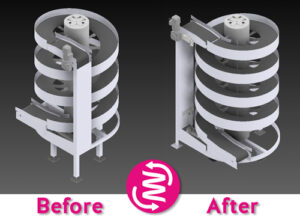 Every warehouse manager knows the sinking feeling when they spot a line of carts snaking around aisles, waiting to unload. Warehouse bottlenecks eat up time, space, and money. But what if one piece of equipment could untangle many of these gridlock points?
Every warehouse manager knows the sinking feeling when they spot a line of carts snaking around aisles, waiting to unload. Warehouse bottlenecks eat up time, space, and money. But what if one piece of equipment could untangle many of these gridlock points?
If you’re juggling high-volume orders and tight staffing, the right conveyor system can be a game-changer.
Spiral conveyors, in particular, offer a space-efficient method to handle vertical transport and streamline your operations.
1. Identifying Common Bottlenecks
As a first step it is helpful to analyze which part of the operation is causing the bottlenecks. Here are some examples:
- Floor Space Limitations
Cramped layouts lead to traffic jams and slow throughput. - Multiple Transfer Points
Conventional conveyors might require several transitions to move products between levels. - Manual Handling
Moving goods up and down floors manually is time-consuming and increases safety risks.
2. How Spiral Conveyors Address These Challenges
Vertical Space Utilization
Spiral conveyors tap into an often-overlooked dimension in warehouse design: vertical space.
 Instead of letting products sprawl across precious floor area, these conveyors elegantly guide them upward (or downward), freeing up pathways that might otherwise be blocked by long conveyor lines. Operations managers who switch to spiral conveyors often discover that by moving items vertically, they can expedite loading, unloading, and sorting processes without sacrificing valuable floor space.
Instead of letting products sprawl across precious floor area, these conveyors elegantly guide them upward (or downward), freeing up pathways that might otherwise be blocked by long conveyor lines. Operations managers who switch to spiral conveyors often discover that by moving items vertically, they can expedite loading, unloading, and sorting processes without sacrificing valuable floor space.
Continuous Product Flow
Fewer transfer points mean less downtime and fewer jam-up points. Rather than relying on multiple transfer points—which can create friction, jams, or pauses—spiral conveyors maintain a smooth, steady movement. The fewer stops your products make, the less chance of pile-ups, and the more consistent your throughput remains throughout the workday.
Reduced Manual Labor
Automating vertical transport allows your team to focus on higher-value tasks.
3. The Power of Modular Design
 A modular spiral conveyor can be reconfigured as your needs evolve. Unlike welded systems, modular sections can be added, removed, or adjusted without major downtime. This helps you adapt to fluctuating demand or layout changes with minimal disruption. If you need to adjust the height or the angle, you can often do so without scrapping the entire system. This adaptability helps future-proof your facility, ensuring that as you scale or shift gears, your conveyor system scales with you.
A modular spiral conveyor can be reconfigured as your needs evolve. Unlike welded systems, modular sections can be added, removed, or adjusted without major downtime. This helps you adapt to fluctuating demand or layout changes with minimal disruption. If you need to adjust the height or the angle, you can often do so without scrapping the entire system. This adaptability helps future-proof your facility, ensuring that as you scale or shift gears, your conveyor system scales with you.
4. Practical Considerations for Operations Managers
- Throughput Goals
Make sure the spiral’s speed aligns with your expected load. - Maintenance Access
Even the best system needs upkeep; plan enough space for maintenance tasks. - Integration Points
Spiral conveyors should seamlessly merge with your existing lines, scanners, or sorters.
Don’t let traditional bottlenecks stifle your warehouse productivity. By investing in a spiral conveyor—especially a modular solution—you can elevate your throughput while making the most of your available space.Ready to reduce bottlenecks in your own facility? Contact Ryson for expert guidance on designing a spiral conveyor system that fits your unique operations.









